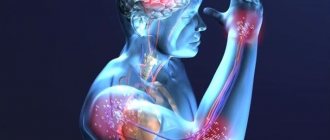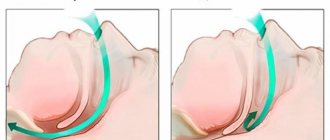The state of suffocation or asphyxia is a life-threatening condition in which there is an acute lack of air and a person cannot breathe normally. This pathological phenomenon is always accompanied by a state of panic and fear of death. This condition is truly frightening, especially for those who experience it for the first time. In addition to mechanical asphyxia, in which a lack of oxygen is associated with a physical blockage of the air flow path or the inability to perform respiratory movements due to external restrictions, there is suffocation associated with various diseases and pathological conditions. It can appear at night in a dream, or during the day, for no apparent reason, at work or in transport, and it is great to scare both the patient himself and those around him.
Choking: what is it, how does it manifest itself?
Content:
- Choking: what is it, how does it manifest itself?
- Main causes of suffocation
- Pathogenesis of asphyxia: mechanism of manifestation
- Characteristic symptoms of the disease
- Lack of air in the fetus and asphyxia of the newborn baby
- Panic attacks, choking due to nervousness
- Why does suffocation occur at night?
- First aid and treatment for choking
Choking or asphyxia is a feeling of lack of air that can last as an attack or a prolonged background condition that develops gradually or suddenly. Often this feeling is accompanied by the fear of death and panic that rolls over the person.
Why does suffocation occur, and how is it expressed? The state of asphyxia accompanies some diseases, mainly related to the pathology of the bronchopulmonary and cardiovascular systems, as well as allergic edema of the upper respiratory tract. With lung disease, there is a decrease in their ventilation capacity, which leads to a decrease in the supply of oxygen to the body, and with obstructive diseases, obstruction or blockage of the bronchial tree occurs with the inflamed bronchial mucosa and air passage is sharply limited. With bronchial asthma, a sharp spasm of the bronchial wall occurs, which also disrupts the flow of air into the lungs and suffocation develops. When there is a lack of air, a person begins to suffocate, since breathing is a basic, vital process. Accordingly, when the process of oxygen entering the body is disrupted, it begins to signal a mortal danger with a feeling of fear and panic attacks.
In fact, suffocation is the highest degree of shortness of breath, a serious condition of a pathological nature, leading to excessive accumulation of carbon dioxide. As a result, the functioning of the entire body is disrupted. Subjectively, the condition is a sharp limitation of inhalation and a pronounced feeling of lack of air. Severe asphyxia is sometimes called apnea - a pathological process that leads to cessation of breathing.
In the International Classification of Diseases ICD-10, asphyxia is coded R09.0.
Treatment
Help before diagnosis
Choking requires emergency medical care, the main goal of which is to restore airway patency. As a pre-medical measure, it is necessary to ensure an influx of fresh air - open the window, free the patient from restrictive clothing, take the fire victim outside. A foreign object in the respiratory tract should be tried to be removed using the Heimlich maneuver.
Conservative therapy
The choice of etiopathogenetic treatment tactics depends on the immediate cause of suffocation. For burn patients, therapeutic bronchosanitation is relevant; patients with cardiovascular pathology are prescribed cardiotropic drugs. In the treatment of diseases of the respiratory system accompanied by suffocation, the following groups of drugs are most often used:
- Bronchodilators.
Includes beta-agonists, anticholinergics, methylxanthines. Medicines can quickly relieve broncho- and laryngospasm. Drugs in this group are divided into fast-acting and long-acting. Beta-agonists and anticholinergics can be prescribed as a single drug, in combination with each other and with inhaled corticosteroids. - Corticosteroids.
They are used to provide emergency care to patients with bronchial obstruction, laryngospasm, and anaphylaxis. Topical inhaled forms of corticosteroids are used as basic therapy for bronchial asthma, COPD and other diseases of the respiratory system.
If necessary, oxygen therapy and respiratory support are provided. For anaphylaxis, epinephrine is administered. Patients with allergic diseases are prescribed antihistamines and antileukotriene drugs, and allergen-specific immunotherapy is performed. Infectious and inflammatory lesions of the bronchopulmonary system are treated with antibiotics.
Main causes of suffocation
Why might a person develop suffocation? Choking doesn’t just happen without a good reason. This is always a symptom of some serious disease, pathological condition. Therefore, you cannot do without urgent medical help.
Choking can develop as a manifestation of:
- bronchial asthma;
- chronic obstructive pulmonary disease;
- pneumothorax;
- oncological diseases of the upper and lower respiratory tract;
- pneumonia;
- foreign bodies entering the respiratory tract;
- allergic reaction with Quincke's edema;
- chest and respiratory injuries;
- acute coronary syndrome;
- chronic heart failure.
A newborn baby, as well as a fetus in the womb of the expectant mother, can also develop hypoxia, lack of oxygen, and, as a result, intrauterine asphyxia of the fetus.
Diagnosis of suffocation
If the patient is conscious in the first phase, collecting complaints will already lead the specialist to a diagnosis. Pulse oximetry makes it possible to determine the level of oxygen saturation in the blood. To identify the cause, the patient is treated by pulmonologists, endoscopists, traumatologists, neurologists, etc. If time permits, X-ray examination methods, bronchoscopy, etc. are performed.
If asphyxia acutely threatens the patient’s life, it is necessary to provide assistance, and the cause is established after stabilization of his condition.
Pathogenesis of asphyxia: mechanism of manifestation
Attacks of suffocation can have a different nature. Depending on the causes of asphyxia, there are:
- bronchial type of pathology (associated with impaired bronchial obstruction);
- cardiac: develops due to stagnation in the pulmonary circulation;
- mixed: the condition is characterized by complex dysfunction of the respiratory and cardiovascular systems.
The state of suffocation occurs when a section of the respiratory tract narrows, and a distant breathing noise is formed - stridor due to the turbulent passage of air. It can be inspiratory or during inspiration, expiratory - during exhalation or mixed. Against the background of developing respiratory failure during the period of suffocation, stridor is accompanied by cyanosis.
The classic type of bronchial obstruction involves the appearance of a sudden attack, which gradually increases and develops from several minutes to several hours. The patient is forced into a sitting position, breathes frequently and noisily with his mouth open, his nostrils flare, pulsation and swelling of the neck veins appear when inhaling. At the end of the attack, a strong cough appears, and mucous sputum is released profusely.
Choking in cardiac asthma also appears suddenly, due to the massive release of transudate into the lung tissue and a sharp disruption of gas exchange. The patient is forced to take a sitting position, since in a horizontal position breathing is extremely difficult, he has frequent bubbling breathing, cyanosis, and a cough with foamy bloody sputum. At the same time, inhalation and exhalation can be very painful.
Bronchospasm similar to asthmatic is observed in patients with carcinoid syndrome. In a state of suffocation, a person experiences hyperemia of the facial skin, rumbling in the stomach and bloating.
How to avoid seizures?
If a person already has bronchial asthma, it is important for him to take medications prescribed by a doctor and follow his recommendations. Treatment should be continued even if there are almost no symptoms. If they worsen, if attacks become more severe or occur more often, you need to meet with your pulmonologist and get new prescriptions.
To prevent bronchospasm you need:
- Avoid triggers. To do this, it is important to know what exactly can cause an asthma attack. The risk of contact with a trigger cannot be completely eliminated, but it can be significantly reduced and its effects can be limited. For example, if an attack may be triggered by tobacco smoke, you can avoid places where there is smoking and try not to be around smokers.
- Use medications correctly. The attending physician may recommend using an inhaler, spacer, or nebulizer. Each of these devices, as well as each of the rapid-acting drugs for relieving bronchospasm, has specific application features. It is important to know about them and practice using the medicine correctly. An inhaler or other device to relieve an attack must be carried with you at all times.
- Monitor symptoms. Even before the onset of suffocation, increasing, gradually intensifying symptoms may occur. It’s good if a person knows how to recognize and track them. This helps to understand that bronchospasm is beginning. Headache, difficulty breathing, and allergy symptoms may indicate an approaching attack.
- Monitor your health. To ease the course of asthma, it is important to stop smoking and prevent excess weight. It is necessary to strengthen the immune system to reduce the risk of respiratory and viral diseases. Vaccination can also help with this. If an asthma attack is likely to be triggered by cold air, it is important to wear a scarf or bandage to cover your mouth and nose in cool weather.
Characteristic symptoms of the disease
Choking due to bronchial asthma
Bronchial asthma is a chronic disease of inflammatory nature, accompanied by bronchial hyperreactivity associated with immunopathological mechanisms and the main symptom of which is an attack of suffocation due to inflammatory swelling of the bronchial mucosa, bronchospasm and hypersecretion of mucus. If the disease lasts for a long time, its inflammatory nature leads to irreversible morphological and functional disorders in tissues.
Difficulty breathing occurs as a result of increased excitability of the bronchi, to which the respiratory tract reacts by developing a spasm and limiting the flow of air into the lungs.
Why does a person develop bronchial asthma? The root cause of the condition is the entry of an allergen into the body, in response to which the patient develops bronchospasm at different levels and a disruption of gas exchange processes. Non-allergic asthma attacks are much less common. The problem may lie in brain injury or developing endocrine disorders. The infectious-allergic type of asthma is formed as a result of chronic infection of the respiratory system, therefore this form of the disease is diagnosed in adults, and much less often in children. Pathogenic microorganisms and inflammatory processes lead to pathology of the bronchi, their anatomical structure and functions change. The non-infectious form occurs due to other allergens - it can be wool, food, medications, dust, chemicals.
During an attack, a sick person has severe wheezing, shortness of breath, and a dry cough. Particularly often, attacks overtake the patient at night, during sleep. To provide assistance, it is necessary, first of all, to stop an attack of suffocation, and also to determine the cause of the disease, for which you will need to undergo a set of appropriate examinations.
Obstructive pulmonary disease
This is a disease that develops as a result of an inflammatory reaction to the action of certain environmental irritants, which is manifested by a progressive decrease in the speed of air flow in the lungs and an increase in respiratory failure. The main provoking factors are smoking and occupational hazards, namely work in hazardous industries, for example, in a coal mine, in cement production. Predisposing risk factors contributing to the development of COPD:
- passive smoking;
- level of nutrition and socio-economic component of life;
- prematurity;
- hereditary factor.
The patient has a cough with increased mucus secretion, as well as disruption of the ciliated epithelium lining the respiratory tract. Against the background of obstructive pulmonary damage, a narrowing of the lumen of the pulmonary vessels occurs, pulmonary hypertension occurs, which leads to expansion of the right chambers of the heart (pulmonary heart) and the addition of heart failure.
Due to disturbances in pulmonary gas exchange, the main symptom occurs - shortness of breath, especially worse with movement and walking.
How to diagnose obstructive syndrome in a patient? First of all, the pathology is characterized by the presence of a constantly worsening cough. During a cough, a large amount of mucous sputum is released, and when an infection occurs, purulent sputum is released. Shortness of breath in this disease is gradually increasing, worsens with physical activity, and develops over time into suffocation.
Pneumothorax
It is formed as a result of a violation of the tightness of the lungs, as a consequence of a chest injury, when a certain amount of air accumulates in the pleural cavity. If after a while air stops flowing into the cavity, then we are talking about a closed pneumothorax. The open type of pathology implies that the air in the pleura constantly and unhinderedly communicates with the air of the environment. Vent or tension pneumothorax develops when, when inhaling, air is sucked into the pleural cavity, but when exhaling, it cannot come out without closing (collapsing) the defect.
Difficulty breathing occurs due to the difference between the air pressure inside the pleura and the atmospheric air. In this case, without emergency medical assistance, the person is at risk of death from both suffocation and traumatic shock.
Tumor lesions of the larynx, trachea, bronchi
In the respiratory organs, as in any other organs, both benign and malignant tumors, as well as tumor-like formations, can form - these processes cause mechanical injuries, harmful production factors, overstrain of ligaments, and their improper use during singing. For example, the appearance of tumors of the vocal cords is accompanied by hoarseness of the voice and rapid fatigue of the cords. A neoplasm on the vestibule of the larynx is manifested by a sensation of a foreign body, a feeling of a lump in the throat when swallowing. Sometimes the presence of a tumor causes sharp shooting pain in one or both ears. The appearance of ulcers on the tumor is accompanied by putrid, unpleasant odor from the mouth, as well as the release of ichor in the saliva.
Laryngeal tumors are very difficult to detect in the early stages, since they practically do not manifest themselves at all. Only over time does difficulty breathing and hoarseness in the voice appear. If a neoplasm appears on the trachea, along with it the person begins to suffer from a cough with sputum. Blood is visible in the mucus discharge.
Asphyxia also occurs in cases where tumors in the respiratory tract grow, causing mechanical obstruction with impaired air flow. To ensure free breathing, the patient needs emergency removal of tumors. It should be noted that such a measure brings only a temporary result, and gradually a new tumor may form in the patient.
The use of a stent (a mechanism in the form of a small mesh tube) makes it possible to eliminate suffocation and difficulty breathing. When folded, it is inserted through a bronchoscope, after which it expands in the respiratory tract and creates unimpeded penetration of air into the lungs.
Edema of the lungs and larynx
Swelling of the larynx accompanies some pathologies and is not regarded as an independent disease. It usually occurs as a result of inflammation, after mechanical trauma, for example, burns from hot drinks and aggressive chemicals, due to suppuration in the pharynx, tonsils, and root of the tongue. Radiological burns occur after radiotherapy or X-ray therapy of the neck and organs in this part of the body.
Another reason that provokes the appearance of laryngeal edema is acute or chronic infectious diseases:
- measles;
- diphtheria;
- scarlet fever;
- typhus;
- flu;
- syphilis;
- tuberculosis.
Edema of a non-inflammatory nature is formed as a sign of kidney, heart and vascular disease, general cachexia, due to lack of protein, liver cirrhosis, circulatory disorders, and also due to disease of the lymphatic system. In the case of allergies, the swelling is called angioedema, and usually spreads to the face and neck.
Swelling is especially pronounced in those parts of the larynx where loose connective tissue predominates - in the area of the epiglottis, posterior laryngeal wall, aryepiglottic folds, and less often it appears in the area of the vocal folds.
The patient feels the presence of a foreign body inside, he constantly has difficulty swallowing, voice disturbance, and a feeling of constriction of the larynx, which is characterized by the formation of a false croup. Laryngeal stenosis especially often occurs at night, and a person wakes up from a sudden attack of suffocation.
Pulmonary edema is a fatal condition for the victim, as it is accompanied by massive penetration of the liquid part of the blood into the lung tissue. May be accompanied by myocardial infarction, myocarditis, hypertension, cardiosclerosis, chronic and acute heart failure, accompanied by the formation of acute left ventricular failure, pneumosclerosis, chronic bronchitis, and damage to the nervous system. It can also develop due to poisoning or allergies.
In some cases, swelling of the lung tissue is formed as a reaction of the body:
- for the administration of drugs;
- for the extraction of ascitic and pleural fluid;
- for transfusion of too large volumes of solutions.
The process of edema development depends on an increase in pressure in the pulmonary circulation and an increase in the permeability of capillary walls. Such conditions are accompanied by effusion of the liquid part of the blood into the alveoli, as well as into the interstitial lung tissue.
The transudate that accumulates in the alveoli has a high concentration of protein that forms foam. Foam helps reduce the respiratory surface area of the lungs, and the patient develops severe respiratory failure, accompanied by suffocation.
The danger of the pathology also lies in the fact that it can develop even in a healthy person after too intense physical activity, if as a result he has a rupture of the chordae tendineae in the mitral valve. Against this background, acute mitral insufficiency develops. The patient, in addition to the acute state of asphyxia, develops a cough with foamy sputum, pink-colored with blood.
Lack of air due to pneumonia
Pneumonia is an inflammatory process in the lungs of an infectious nature, the causative agent of which can be varieties of pathogens, fungi, viruses, bacteria, developing independently or as a complication of other diseases. It affects the alveoli of the lungs, the main function of which is to participate in gas exchange and the supply of oxygen to the body’s blood.
Pneumonia most often occurs in people with weak immune systems, the elderly and children. The disease usually begins acutely, with high fever, weakness, increased sweating, shortness of breath and, in severe cases, suffocation. If the development of the disease occurs gradually, the patient is bothered by a dry cough, lethargy, fatigue and headache.
Depending on the location of the inflammatory process, pneumonia occurs:
- focal: the disease occupies a small part of the lung tissue;
- lobar: the entire lobe of the lung becomes inflamed;
- segmental: occupies one or more segments of the lung;
- confluent: in this case, inflammation begins with small foci and gradually merges into larger foci;
- total: the most severe version of pneumonia, when the pathological process spreads to the entire lung.
Oncological processes in the lungs
They represent the formation of malignant neoplasms that affect the walls of the bronchi and lungs, grow rapidly, and metastasize to nearby organs and tissues. Lung cancer is one of the most common cancers in the world. Its symptoms are so characteristic that it is difficult to confuse it with other pathologies. Tumors in the lungs are more often found in middle-aged men, especially often in smokers and passive smokers.
Gradually growing tumors displace lung tissue, affect their internal structure, make breathing difficult and cause suffocation in a person along with coughing, chest pain, as well as weight loss and lack of appetite.
Entry of foreign bodies into the respiratory tract
This problem is most relevant for young children, especially under 3-5 years old. In the process of learning about the world around them, children love to put into their mouths everything that comes to hand - small coins, small toys, peas. When you inhale sharply, for example, when laughing, frightened, or crying, these objects quickly and easily fall into the lumen of the larynx. The most common way foreign objects get in is during a conversation or while eating. By closing the lumen of the trachea with itself, the element blocks the access of air to the lungs. When a foreign object enters the larynx, it provokes a coughing attack - a reflex cough helps to push the element out through the oral cavity. However, in cases where a foreign body completely closes the lumen of the larynx or trachea, the victim experiences asphyxia, loss of consciousness, and then respiratory and cardiac arrest. The condition requires immediate first aid, otherwise the person dies in a matter of minutes.
When the bronchi are blocked, an inflammatory process develops in a person. Incomplete blockage of the airways is accompanied by severe bouts of coughing, noisy breathing with wheezing, and hoarseness. The patient feels panic, fear and anxiety. Against the background of insufficiency of air, cyanosis is observed in the skin of the face and upper body, widening of the wings of the nose when a person tries to draw in air through the nose as intensely as possible, as well as retraction of the intercostal spaces.
Complete blockage means that the patient is not able to take a breath at all, he loses his voice, and very quickly loses consciousness due to oxygen deficiency and dies if qualified assistance is not provided in time.
Anaphylactic shock in allergy sufferers
Anaphylactic shock refers to a deadly condition of allergy sufferers, when the victim experiences acute vascular collapse and lack of air. An immediate allergic reaction develops in response to exposure to an allergen in large quantities.
The condition is accompanied by vascular collapse and depression of vital functions. The patient has noticeably intense redness of the skin, he is tormented by a feeling of tightness behind the sternum, severe suffocation and lack of air, as well as increasing swelling of the tissues.
Severe swelling of the upper respiratory tract leads to complete disruption, to which the central nervous system reacts with a state of abnormal arousal, an attack of fear, and depression of consciousness. Then the person falls into a coma and dies if he does not receive medical help.
If a patient has an allergic reaction and anaphylactic shock of moderate severity, he also experiences breathing problems, shortness of breath, a hoarse voice, he develops a cough, and he also needs medical attention, but the life-threatening condition does not develop so rapidly.
Often the cause of anaphylactic shock is an insect bite, injection of drugs, ingestion of pollen, blood products, chemical elements and certain foods.
Chest injuries, myocardial infarction
Asphyxia occurs as a result of prolonged and strong compression of the chest or upper abdomen. A disturbance in the venous outflow from the upper half of the body develops in the body, venous pressure increases, as a result of which the victim develops multiple small hemorrhages in the skin, mucous membranes, brain and internal organs. Due to impaired blood circulation, the skin becomes bluish in color.
Traumatic asphyxia is often accompanied by contusion of the lungs and heart, and liver damage. In addition to pinpoint hemorrhages, the patient experiences alternating periods of agitation and lethargy, severe respiratory failure, swelling of the face, visual disturbances, rapid shallow breathing, and sometimes even impaired coordination and orientation in space. Without medical assistance, such a victim stops breathing and cardiac activity, resulting in death.
Myocardial infarction is a pathology that occurs as a result of obliteration or stenosis of the coronary arteries. Due to the fact that blood from the blocked artery cannot flow normally into the heart, the heart muscle experiences acute hypoxia and undergoes a necrotic process. Normally, a specific area of the heart receives oxygen dissolved in the blood that is supplied to it by the artery. Blockage of this artery within 30 minutes provokes the death of heart muscle cells. In place of dead tissue, inelastic scars appear, due to which the organ cannot fully function. The heart, whose main function is pumping, begins to pump blood less easily as a result of a heart attack. During a heart attack, a patient experiences anxiety, pain in the heart and chest, lack of air and suffocation. Pain can migrate from the sternum and radiate to the jaw, arm, shoulder, or back.
The risk group for the development of pathology is overweight people, smokers, hypertensive patients, as well as those who lead a sedentary lifestyle, the elderly. You can recognize the approach of a heart attack by more frequent attacks of angina with shortness of breath and pain in the heart, but such a prodromal period does not always develop.
A dangerous complication of a heart attack is acute left ventricular failure and post-infarction pericarditis. In this case, patients experience a severe deterioration in well-being, accompanied by the following symptoms:
- swelling of the neck veins;
- severe shortness of breath;
- ascites;
- swelling of the legs;
- clouding and loss of consciousness.
Symptoms
The feeling of suffocation in the throat rarely comes alone.
Most often it is accompanied by other symptoms, sometimes no less unpleasant. Let's find out what these additional symptoms are. During a conversation, a persistent feeling of discomfort appears. It is difficult for a person to speak; there is a feeling that something in the throat is preventing this.
Feeling of a lump in the throat. Moreover, this “lump” not only interferes with speaking, but also makes it difficult to swallow and interferes with breathing.
In the video, the appearance of a lump in the throat:
When swallowing, painful sensations appear. Sometimes this even leads the patient to a complete refusal to eat due to too uncomfortable sensations during this process. Such refusal is especially dangerous for children, as it leads to weakness and rapid weight loss in the child.
You may feel heaviness in the back of your head, headache, and even loss of consciousness. The last symptom is expressed if there are disturbances in the circulatory system or central nervous system. Symptoms of pharyngeal neurosis may also include numbness and partial or complete absence of the pharyngeal reflex.
A feeling of numbness in the limbs is a symptom that is also sometimes associated with a feeling of suffocation. This symptom develops due to circulatory problems or neurological causes.
All additional symptoms can help the doctor make a diagnosis faster and more accurately and begin treatment. Therefore, at an appointment with a specialist, voice all the symptoms that worry you. And the doctor will be able to draw the appropriate conclusion from them.
Lack of air in the fetus and asphyxia of the newborn baby
Obstetricians-gynecologists note that such pathologies are the most common in their practice in children, from the 28th week of pregnancy to the seventh day after birth.
Fetal hypoxia is characterized by an increasing lack of oxygen while in the womb or during childbirth. The child develops a decrease in the supply of oxygen to the body, an increase in the concentration of under-oxidized toxic metabolic products in the blood, as a result of which metabolic and redox reactions are disrupted. The baby's respiratory center becomes more irritated, carbon dioxide accumulates, and the fetus has to breathe through an open glottis. With such breathing, all the elements and liquids located around it enter the body - this is blood, amniotic fluid, mucus.
Fetal hypoxia can occur against the background of impaired fetoplacental circulation, diseases of the pregnant woman, intoxication, the presence of extragenital diseases, umbilical cord pathologies, intrauterine injuries and infections, and genetic disorders. This condition can be detected by the presence of arrhythmia and deafness of heart sounds in the fetus. In the early periods of hypoxia, active movement of the fetus is observed, after which movements gradually become less frequent and slower. Asphyxia of the fetus and, subsequently, the child, becomes the cause of the development of intrauterine and birth disorders, defects, and pathologies.
Neonatal suffocation is characterized by the presence of cardiac activity in the absence of breathing, or with the presence of unproductive respiratory movements. For infants, it is especially important to take timely measures to restore normal respiratory activity - artificial ventilation, correction of metabolic disorders and energy balance.
Treatment of throat spasms and choking
How to quickly get rid of painful spasms in the pharynx that accompany the pathological condition?
The following tips are most effective in this case:
- The first step is to ensure peace and quiet for the patient.
- Open the window to allow fresh air into the room.
- To bring a person to consciousness, you can use ammonia.
- Give the patient a little water (about 100 ml) at room temperature to drink.
- If a person’s condition does not return to normal, you should pat him on the back without making too much effort.
- To relieve severe spasm in the larynx, you can artificially induce vomiting or place the patient in a warm bath.
- If the pathological process occurs against the background of a stuck bone in the throat, then the patient should be urgently sent to the surgical department of the nearest hospital.
- The periodic occurrence of convulsions in the upper respiratory tract should be a reason to immediately call an ambulance. Sometimes this indicates the presence of a serious illness.
If you are confident that asphyxia will develop due to nervous tension, then you should use the most effective treatment methods:
- psychotherapy;
- treatment with medication (an antidepressant and a tranquilizer will quite quickly remove a person from a pathological condition).
If the cause of convulsive spasms is allergic edema, then specialists usually prescribe effective drugs such as:
- Diphenhydramine;
- Suprastina;
- Tavegila.
When spasms appear against the background of pronounced bronchial asthma, it is most advisable to use drugs that help normalize the functioning of the bronchi.
Panic attacks, choking due to nervousness
It is impossible not to note the likelihood of developing suffocation in the presence of mental and nervous diseases. For example, a state of suffocation is a characteristic symptom of panic attacks. Some doctors attribute panic attacks to manifestations of VSD - vegetative-vascular dystonia.
About 40% of the world's population have experienced a panic attack at least once in their life. Women are considered more susceptible to attacks than men, since the main cause of anxiety disorder is severe emotional stress.
Panic attacks can develop both as a result of chronic, prolonged overexertion, and due to a sharp feeling of intense emotional stress. People with a suspicious and anxious character are at particular risk. Under the influence of external factors that traumatize the psyche, a person experiences a conflict between the unconscious and the conscious in the psyche, as a result of which the unconscious breaks through, including signs of a panic attack.
How to recognize a panic attack and distinguish it from a simple attack of fear? It should be noted that diagnosing the condition mainly depends on the subjective perception of the patient himself. He has a rapid heartbeat and high rapid pulse, trembling in the limbs, severe dizziness, pain in the left side of the chest, numbness in the arms and legs, spasm in the throat, difficulty breathing and suffocation. All this is accompanied by a depressing feeling of fear. The attack occurs abruptly, suddenly, and lasts up to half an hour. Treatment can be carried out either with medication or with the use of psychotherapy.
Nervous suffocation is what is most often called hyperventilation syndrome. The syndrome is a psychosomatic disease that causes respiratory dysfunction. The disease manifests itself as sudden attacks of lack of air and suffocation under the influence of stress and dangerous mental factors, and is a form of neurocirculatory dystonia.
In fact, with hyperventilation syndrome, a person, feeling the impact of stressful and dangerous factors, begins to breathe sharply and with effort. As a result, he develops a deviation from the norm in the acid-base state, as well as a change in the concentration of the electrolyte composition.
External manifestations of hyperventilation:
- dizziness;
- trembling in the body and limbs;
- chest pain;
- lump and sore throat;
- choking and difficulty breathing;
- convulsions;
- muscle stiffness.
A certain role in the development of the syndrome is played by the patient’s suspiciousness and anxiety - when hyperventilation occurs, such a person remembers them, and his body unconsciously reproduces them in subsequent stressful situations.
Respiratory neurosis
There are many types of neuroses, each of which is distinguished by a specific group of symptoms. One of them is respiratory neurosis, which is characterized primarily by neurogenic breathing disorder.
The concept was introduced into use in 1871 by the American scientist Da Costa. It has several related names: “respiratory neurosis”, “neurorespiratory syndrome”, “respiratory dystonia”. But the term most often used is “hyperventilation syndrome” (HVS) . It accounts for approximately 10% of cases. Among the patients there are both children and adults. It is worth noting that women suffer from this disease several times more often than men.
The causes of the syndrome are divided into mental, organic, and mixed. Of course, the majority (about 60%) is due to psychogenic factors.
5% of cases include organic etiology. These include disorders of the structure of the central nervous system: encephalopathy, hydrocephalus, inflammation of the meninges, as well as diseases such as diabetes, hypertension, chronic bronchitis. Sometimes the reason is taking certain medications.
During the course of the disease, there are 3 groups of signs:
- respiratory;
- psycho-emotional;
- muscular.
Group I has several forms of manifestations:
- Empty breathing is a feeling of lack of air, its pace quickens.
- It seems that air is forced into the lungs, and there is a lump in the throat. Accessory muscles are involved in the respiratory act.
- A premonition of breathing stopping appears, and the person is forced to control its process by consciously inhaling.
- Yawning, moaning, sighing.
Group II symptoms include nervous tension and concern about one’s condition. The patient cannot relax. He develops phobias, in particular, a fear of open areas and places with large crowds of people.
Symptomatic group III includes muscle hypertonicity, various tactile sensations in the form of tingling, burning, and “goosebumps.”
This triad of symptoms is a typical, leading manifestation of the disease.
The disease is characterized by a chronic course, in which exacerbations occur.
An exacerbation of hyperventilation syndrome is called a hyperventilation crisis. This is a condition in which the manifestations of the disease intensify. Characterized by an increased sense of fear. The patient is suffocating, hysterical, and feels “near death.” At the same time, he is accompanied by chills, dizziness, nausea, and becomes covered in sticky cold sweat.
A crisis is caused by a negative psychological environment. A unique way to relieve an attack is to breathe into a bag. In this case, carbon dioxide is concentrated in it, which the neurotic inhales. Gas balance is restored, breathing is leveled out. This is the first aid in this situation.
As for children, they are also characterized by such a pathology as respiratory neurosis, which is also caused by stress, phobias and anxiety disorders. But it is worth noting that the main role in their occurrence is played by an unfavorable situation in the family, and this applies not only to rude and inadequate attitude towards the child, but also to the relationship between parents. Constant quarrels and conflicts in the family, aggression can provoke the development of psychogenic shortness of breath in children.
Such children are characterized by anxiety and lability (instability) of mood. They experience outbursts of anger over trifles, general nervousness, refusal to communicate with friends, and sleep disturbances.
Parents should be more vigilant and sensitive in raising their children.
Why does suffocation occur at night?
Night suffocation and lack of air can occur for several reasons. First of all, the problem is a change in the tone of the autonomic nervous system, a change in the position of a person lying in bed. As a result, there is an increase in blood filling in the lungs.
The state of night suffocation is usually difficult for patients to tolerate: in their sleep they try to catch air with their mouths, the skin is covered with cold, sticky sweat, and tachycardia is observed. Until a person wakes up, he may be accompanied by a nightmare. Wheezing and ringing crepitations are heard in the lungs.
Such symptoms are characteristic mainly of the initial stages of the development of pathology - they can only be heard in the area above the bases of the lungs. Most patients with nocturnal attacks also suffer from signs of heart failure - an enlarged liver, swelling of the subcutaneous fat, increased venous pressure and swelling of the veins in the neck.
In the presence of left ventricular failure, the patient experiences attacks of suffocation, alternating with coughing attacks. The usual picture of the disease is when a person suddenly wakes up in the middle of the night from lack of air and begins to cough, strenuously gasping for air.
In severe cases, paroxysmal suffocation can develop into a dangerous condition - pulmonary edema.
Methods for treating a feeling of choking in the throat
To cope with the feeling of tightness in the throat, it is imperative to treat the underlying pathology. The choice of medications and procedures directly depends on the diagnosis.
So, if the functioning of the thyroid gland is impaired, iodine preparations must be prescribed . If autoimmune thyroiditis is diagnosed, therapy is more complex. In some situations, a person has to take hormonal medications for the rest of his life.
If the reason lies in damage to the cervical spine, it will not be possible to do without therapeutic exercises . The doctor may also recommend physical therapy - vacuum treatment, manual techniques, reflexology, laser therapy. Normalizing your lifestyle and following the rules of a healthy diet is of no small importance.
- Why pain occurs during menstruation: causes of discomfort
The most dangerous condition is the formation of a malignant tumor. In such a situation, it will not be possible to do without radiation and chemotherapy. In some cases, there is a need for surgical intervention.
When gastroenterological problems occur, treatment consists of following a special diet and using medications. However, if a hernia forms in the esophagus, surgery may be necessary.
With the development of inflammatory lesions of the otolaryngological organs, it is necessary to evaluate the nature of the disease - it may be of viral or bacterial origin. Based on the results of the studies, antibacterial drugs or other medications may be prescribed.
In addition to the main therapy, gargling with infusions of medicinal plants, preparations containing iodine or salt can be used. All of these products are distinguished by pronounced anti-inflammatory and healing characteristics. In some situations, warming compresses will help to enhance drug therapy.
If the feeling of tightness in the throat is due to psychogenic factors, therapy involves the use of medications and psychotherapeutic agents. If a patient is diagnosed with depression, he is prescribed antidepressants and tranquilizers.
If breathing problems occur that are associated with the appearance of panic attacks, measures are taken to eliminate the symptoms of vegetative-vascular dystonia.
It is recommended to do breathing exercises on your own, which provides effective relaxation. To do this, you need to breathe with your stomach or use a bag, holding your breath for a certain time. The exact set of exercises will be selected by your attending physician.
When a coma occurs for the first time, you can perform several breathing exercises, trying not to focus attention on this condition. At the same time, it is important to control swallowing movements - they should not become more frequent. An additional remedy to improve the condition would be herbal infusion or tea. Subsequently, it is recommended to perform exercises for the muscle tissue of the neck and larynx.
How to get rid of the feeling of a lump in your throat











